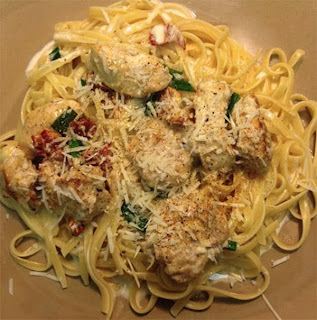With Burns night only a few days away (25th Jan), this recipe can easily be adapted for a Burns Supper by making the gingerbread into a Parkin. To do this, simply substitute the 240g (2 cups) plain flour with 180g (1 1/2 cups) plain flour and 60g (1/2 cup) fine oatmeal in the recipe below.
Gingerbread with Lemon Sauce
Serves:10
 Ingredients:
Ingredients:
For the Gingerbread:
240g (2 cups) plain flour, sifted60g (1/2 cup) wholemeal flour
100g (1/2 cup) sugar
1 tsp baking soda
1/2 tsp sea salt
1 tsp ground cinnamon
1 1/2 tsp ground ginger
1/4 tsp ground cloves
2 eggs
250ml (1 cup) buttermilk
180ml (3/4 cup) treacle (molasses)
80ml (1/3 cup) neutral vegetable oil
For the Lemon Sauce:
100g (1/2 cup) sugar1 tbsp cornflour (cornstarch)
1/8 tsp salt
250ml (1 cup) boiling water
2 tbsp butter
1 tbsp freshly-grated lemon zest
3 tbsp lemon juice
Method:
Begin with the gingerbread. Sift the plain flour, sugar, baking soda, salt, cinnamon, ginger and cloves into a large bowl and stir in the wholemeal flour.Beat the eggs in a separate bowl until frothy then stir in the buttermilk along with the treacle and oil. Beat well to combine, then add the liquid ingredients to the dry ingredients, stirring until thoroughly combined.
Pour the resultant batter int a greased baking tin (about 22 x 22 x 5cm [9 x 9 x 2 in] in size). Transfer to an oven pre-heated to 170ºC (350ºF) and bake for about 35 minutes, or until the top of the cake is golden brown and the surface springs back when lightly pressed with the fingertips.
turn the gingerbread out onto a wire rack and set aside to cool before cutting into squares.
In the meantime, prepare the lemon sauce. Mix together the sugar, cornflour and salt in a small pan. Stir in the boiling water until smooth then place the mixture over medium heat and bring toa boil, stirring constantly to prevent lumps from serving. Reduce to a simmer and cook, stirring constantly, until the sauce has thickened and looks clear.
At this point, stir in the butter, lemon zest an lemon juice.
Arrange the still warm gingerbread squares on serving plates, pour over the lemon sauce and serve immediately.














